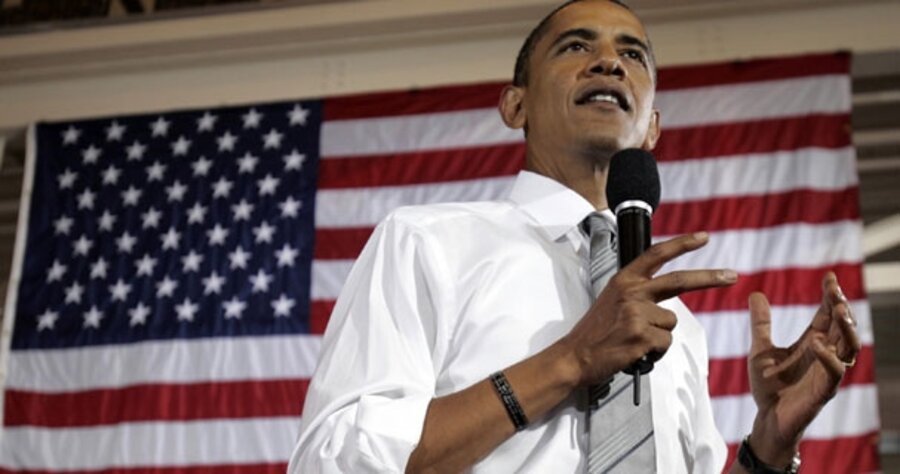Election wild card: first-time voters
Loading...
One week, Barack Obama is up by five or six percentage points. But the next, John McCain leads by three. It’s back and forth, up and down.
So how do we know who’s ahead?
More than in any other presidential election in recent times, polls may be failing to capture accurately what’s happening in the American electorate. There are a couple of reasons, but the most key for the pollsters are massive voter-registration drives, especially by the Democrats, which have created millions of first-time voters. Pollsters aren’t quite sure yet how to calculate the impact of all these new voters on the election.
“The polls could be inaccurate because it’s hard to know how to weight first-time voters. That’s a major problem for pollsters, and there’s a lot of volatility in the electorate now,” says Darrell West, director of governance studies at the Brookings Institution in Washington. “Most of the traditional polling methods are based on likely voters, and the likelihood of voting is measured through participation in past elections. Generally, that’s not a big problem because there aren’t that many new voters, but this year, we’ve had a big spike in interest by first-time voters.”
That became especially apparent during the primary season, when voter turnout increased more than 120 percent, and few if any of pollsters predicted it.
The types of people who turned out also caused some surprises. Young people flocked to caucuses and the voting booths, double and even tripling their participation in some states like Iowa. A recent study by Harvard’s Institute of Politics found that in this election, “more than 3-in-5 young voters are excited about the election.”
Hispanics also caught some pollsters off guard during the primaries. A study by the Pew Hispanic Center, a nonpartisan think tank in Washington, found that Latinos made up “a growing share” of the turnout in 16 of the 19 states in which exit-poll comparisons could be made between 2004 and 2008.
The most dramatic increases were in California and Texas. In the 2008 California primary, Hispanics made up 30 percent of the Democratic voters, compared with 16 percent in 2004. In Texas, Hispanics made up 32 percent, compared with 24 percent in 2004, according to the report.
The turnout in November
The challenge for pollsters is to figure out how many of those new voters will go back to the polls in November.
“I’m a little humble here: I think the bigger worry about whether our polling is right is who is going to turn out to vote,” Democratic pollster Stan Greenberg told reporters at a Monitor breakfast during the Democratic National Convention in Denver. “The models aren’t very good from the past, and combine that with the well-funded, serious levels of grass-roots organization that we haven’t seen before, and I’m a little nervous.”
Mr. Greenberg is not alone among pollsters, who are constantly assessing and upgrading the models they use to predict outcomes. Some of the other variables they now have to consider are early voting, which is allowed in 23 states, and same-day registration in a handful of states like Minnesota, Wisconsin, and New Hampshire. Each variable has the potential to throw off the sample of registered and likely voters.
“History becomes less of a guide here ... so we are asking about early voting and first-time voting and tracking that to see if it helps us,” says pollster John Zogby of Zogby International.
Voter registration lists
Some state-level surveys and partisan polls – those done for candidates and their parties – don’t use random phone samples. Instead, they rely on voter registration lists. The method is not considered as reliable because those lists can be out of date. One pollster, who didn’t want his name used so as not to offend colleagues, called the method “on the cheap,” and thus most major pollsters don’t use it. But some pollsters still do.
“If your sample is a year old in Pennsylvania, you’re going to miss a huge amount of movement because of the dramatic, dramatic change in registration in Pennsylvania [before the primary],” says Margie Omero, president of Momentum Analysis, a Democratic polling firm in Washington. “When you compare state-to-state surveys, which is how people come up with what the model will be for electoral votes, that’s something to keep in mind.”
How the issue of race factors into polls can also affect their accuracy. In the late 1980s and early 1990s, particularly in the South, many African-American candidates would find themselves ahead in the polls when voters were asked about their preferences prior to the election. Then they’d lose, when voters expressed their true preference in the polling booth. But that phenomenon – of people being afraid to tell pollsters what they really think when it comes to race – no longer appears to be a significant factor. Indeed, during the primaries, Senator Obama actually did better during some primaries and caucuses than he did in the polls.
One reason for that is that pollsters have come up with elaborate sets of questions to identify voters’ true preferences. But race can still present some problems for pollsters, particularly when those who refuse to participate are taken into account.
“The larger issue is the refusals – whether the people we don’t get are more racially intolerant than the people we do get,” says Andy Kohut of the Pew Research Center for the People & the Press. “That’s a problem child for us.”





